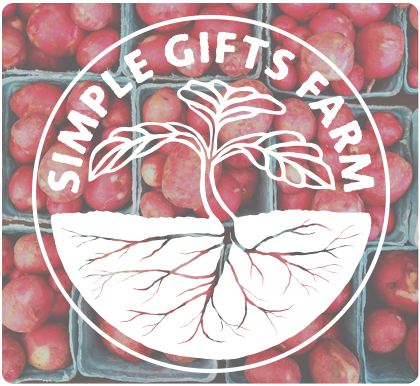As our swiftly tilting planet zooms from summer solstice toward autumnal equinox, I increasingly appreciate the light and warmth of our sun. I’ve been reflecting on this most basic of forces and how we make the most of it at Simple Gifts Farm.
The greenhouse effect, in the original sense
| Happy plants in one of our hoophouses |
The greenhouse effect has a negative connotation, when used in the context of gases in the earth’s atmosphere absorbing and scattering thermal energy, thus allowing the earth’s CO2-enriched atmosphere to hold extra heat. However, using the greenhouse effect in its original sense is critical to powering a local food system. Short wavelength light energy passes easily through the hoophouse plastic, but once converted to longer-wavelength heat energy, reduced airflow inside the structure holds in the warmth. Our array of hoophouses, caterpillar tunnels and greenhouses allow us to extend the growing season. At 42 degrees North, we receive enough sunlight for plants to grow for about 10 months of the year, but heat is more limited. Given protection from the cold, we can harvest some crops year-round. We carefully plan fall hoophouse plantings to take into account slowing growth into late autumn, and very little growth in the dark days of December and January (which Eliot Coleman poetically calls “The Persephone Months”).
As a side note, the ability to keep plant foliage dry and control the amount of water the plants receive is also really important. In a wet summer with high disease pressure, like this one, this is possibly an even bigger advantage than extending the warm season.
Photovoltaic and solar thermal
Our farm is not a closed energy system, and some of the largest energy inputs are used to power our electricity needs. In 2010, we installed a 9.8 kilowatt array on the share barn roof. This supplies approximately 60% of our power needs.
We also have a solar hot-water system that supplements the heat in the greenhouse. During this time of year, we are trying to store some heat in hot-water barrels that we can draw on during the colder months. In January, the level of heat from the solar system is small, but we circulate that warmer water through a radiant heat system so that the heat goes right to the plant roots. By March, the days will be longer and we will be starting our first seedlings of 2014, so we need more heat to get those seeds to germinate and grow. At that point, the solar hot-water system will provide a significant supplement to our wood-pellet boiler,
Photosynthesis
This intricate biochemical dance of photons, water, electrons, chlorophyll, and Rubisco is Nature’s true alchemy. The crop plants of the farm make their own food, given sunshine and water. Pasture-raised cows are one step removed from these producers. Need a photosynthesis review? Check out this rap!
Techno-geek bonus!
In reviewing my facts on photosynthesis and photovoltaics, I came across some provocative lines of research into artificial photosynthesis. I’m a forest ecologist, and know that the wood and food, carbon removal from the atmosphere, beauty, and habitat provided by plants is something that we won’t trump in a lab. However, with the global energy and environmental pressures, an all of the above strategy may have a place for this approach.
Here are a couple of links if you’d like to find out more:
This article from Science magazine in 2011 received a fair bit of attention – here’s a popular write-up from Scientific American, and this articlefrom February 2013 in Optics and Photonics News gives a nice overview of the overall effort.
Warmly,
Audrey

